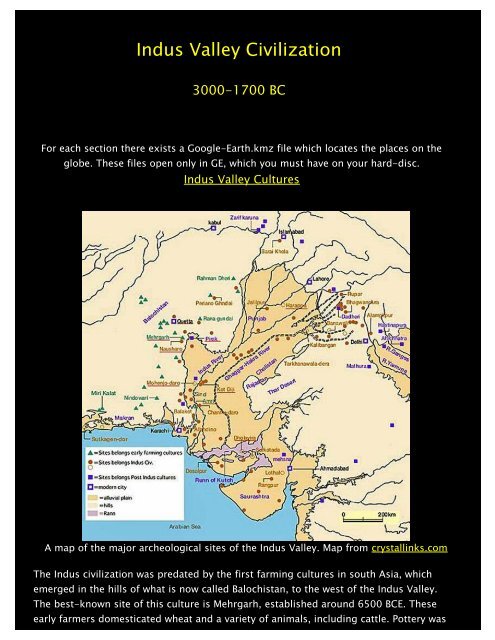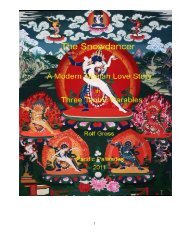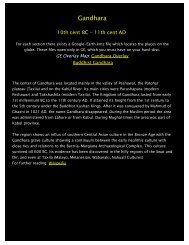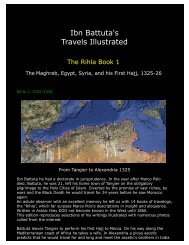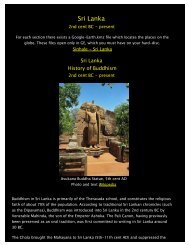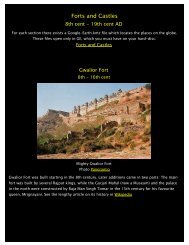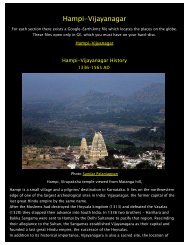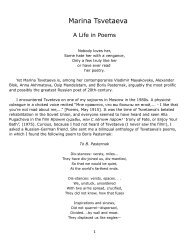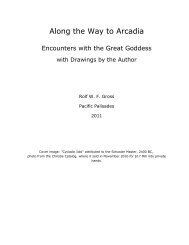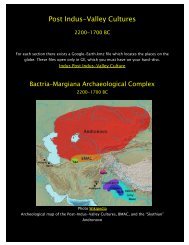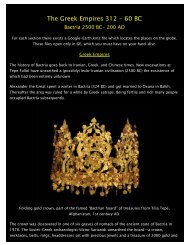Indus Valley Civilization - Rolf Gross
Indus Valley Civilization - Rolf Gross
Indus Valley Civilization - Rolf Gross
- No tags were found...
You also want an ePaper? Increase the reach of your titles
YUMPU automatically turns print PDFs into web optimized ePapers that Google loves.
<strong>Indus</strong> <strong>Valley</strong> <strong>Civilization</strong>3000-1700 BCFor each section there exists a Google-Earth.kmz file which locates the places on theglobe. These files open only in GE, which you must have on your hard-disc.<strong>Indus</strong> <strong>Valley</strong> CulturesA map of the major archeological sites of the <strong>Indus</strong> <strong>Valley</strong>. Map from crystallinks.comThe <strong>Indus</strong> civilization was predated by the first farming cultures in south Asia, whichemerged in the hills of what is now called Balochistan, to the west of the <strong>Indus</strong> <strong>Valley</strong>.The best-known site of this culture is Mehrgarh, established around 6500 BCE. Theseearly farmers domesticated wheat and a variety of animals, including cattle. Pottery was
in use by around 5500 BCE. The <strong>Indus</strong> civilization grew out of this culture'stechnological base, as well as its geographic expansion into the alluvial plains of whatare now the provinces of Sindh and Punjab in contemporary Pakistan and NorthernIndia.By 4000 BCE, a distinctive, regional culture, called pre-Harappan, had emerged in thisarea. (It is called pre-Harappan because remains of this widespread culture are found inthe early strata of <strong>Indus</strong> civilization cities.) Trade networks linked this culture withrelated regional cultures and distant sources of raw materials, including lapis lazuli andother materials for bead-making. Villagers had, by this time, domesticated numerouscrops, including peas, sesame seeds, dates, and cotton, as well as a wide range ofdomestic animals, including the water buffalo, an animal that remains essential tointensive agricultural production throughout Asia today.The <strong>Indus</strong> civilization is still poorly understood. It seems to have died out around 1900BC without leaving an archeological trace. Its undeciphered writing system vanisheduntil Ashoka's introduction of a new, unrelated style of writing Pakrit (2nd cent BC).Among the <strong>Indus</strong> civilization's mysteries are fundamental questions, including itsmeans of subsistence and the causes for its sudden disappearance beginning around1900 BC (Vedic incursions?). We do not know what language the people spoke. We donot know what they called themselves.Mehrgarh, 7000BC - 2600BCMehrgarh is a neolithic site now seen as a precursor to the <strong>Indus</strong> <strong>Valley</strong> <strong>Civilization</strong>(3000 - 1600 BC).Early farming village in Mehrgarh, c. 7000 BC, with houses built of mud bricks.
Archaeologists divide the occupation at the site into several periods. Mehrgarh Period I7000 BC–5500 BC,was Neolithic and aceramic (i.e., without the use of pottery). Theearliest farming in the area was developed by semi-nomadic people using plants suchas wheat and barley and animals such as sheep,goats and cattle. The settlement wasestablished with simple mud buildings with four internal subdivisions. Numerousburials have been found, many with elaborate goods such as baskets, stone and bonetools, beads,bangles,pendants and occasionally animal sacrifices,with more goods leftwith burials of males.Mehrgarh Period II 5500 BC–4800 BC and Merhgarh Period III 4800 BC–3500 BC wereceramic Neolithic (i.e. pottery was now in use) and later chalcolithic.Much evidence ofmanufacturing activity has been found and more advanced techniques were used.Glazed faience beads were produced and terracotta figurines became more detailed.Figurines of females were decorated with paint and had diverse hairstyles andornaments.Clay figurines from Mehrgarh (3000 BC)Photo from crystallinks.comSomewhere between 2600 BC and 2000 BC, the city seems to have been largelyabandoned, which is when the <strong>Indus</strong> <strong>Valley</strong> Civilisation was in its middle stages ofdevelopment. It has been surmised that the inhabitants of Mehrgarh migrated to thefertile <strong>Indus</strong> valley as Balochistan became more arid due to climatic changes.Text and photos (except where noted) from Wikipedia
Nausharo 3000 - 1900 BCNausharo may be the bridge between Mehrgarh and the <strong>Indus</strong> <strong>Valley</strong> culture. If thedates given in Wikipedia are correct Nausharo is not contemporary with early Mehrgarh.Female figurines are plentiful but around 2700 BC appear also male clay figurines,Harappa 3300-1600 BCthe reason is not entirely clear.The ancient city is believed to have had as many as 40,000 residents, ??considered large for itstime. Although the Harappa Culture extended well beyond the bounds of present day Pakistan,its centres were in Sindh and the Punjab.Excavated area at Harappa
A large number of seals were found in Harappa probabely with Sumerian influence. Thiscomplex seal depicts a deity with horned headdress and bangles on both arms,standing in a pipal (sacred fig) tree and looking down on a kneeling worshiper. Ahuman head rests on a small stool. A giant ram and seven figures in processioncomplete the narrative. The figures wear a single plumed headdress, bangles on botharms and long skirts.Another collection of Harappa seals with examples of the <strong>Indus</strong> <strong>Valley</strong> script.
In Harappa large numbers of small terracotta figurines have been found recently (1991).Some may have been votive figures other were apparently children's toys!Collection of burial pottery. Possible date 2500 BC.Photos and text from harappa.comMohenjo Daro 2600-1700 BCMohenjo-daro (Mound of the dead) was a city of the <strong>Indus</strong> <strong>Valley</strong> <strong>Civilization</strong> builtaround 2600 BC and is located in the Sindh Province of Pakistan. This ancient fivethousand year old city is the largest of the <strong>Indus</strong> <strong>Valley</strong> and is widely recognized as one
of the most important early cities of South Asia and the <strong>Indus</strong> <strong>Valley</strong> <strong>Civilization</strong>.Mohenjo Daro was one of the world's(?) first cities and contemporaneous with ancientEgyptian and Mesopotamian civilizations. It is sometimes referred to as "The Ancient<strong>Indus</strong> <strong>Valley</strong> Metropolis".This view shows the high western mound made up of a massive mud brick platform andbrick houses of the Harappan period ( 2600 to 1900 B. C.). On top of the Harappanstructures is a Buddhist period stupa made of mud brick that dates to the first centuryA.D."Great Bath," Mohenjo-daro.The great bath is without doubt the earliest public water tank in the ancient world. Most
scholars agree that this tank would have been used for special religious functions wherewater was used to purify and renew the well being of the bathers.Photos from harappa.comThe socalled "Priest King",one of few sculptures found in Mohenjodaro. Height of figure: 17 cm.Photo from harappa.com
Lothal 2400 BC - 1900 BCReconstruction of the former sea harbor.Photo nalanda international.orgLothal was one of the most prominent cities of the ancient <strong>Indus</strong> valley civilization.Located in the modern state of Gujara チt and dating from 2400 BCE, it is one of India'smost important archaeological sites that dates from that era. Discovered in 1954,Lothal was excavated from 1955 to 1960 by the Archaeological Survey of India.The excavated dock at Lothal visible in GE.The dockyard could hold 30 ships of 60 tons each.This would be comparable to the modern docks at Vishakapatnam.Photo harappa.comLothal was connected to an ancient course of the Sabarmati river on the trade route
etween the Harappan cities in the Sindh and the peninsula of Saurashtra when thesurrounding Kutch desert of today was part of the Arabian Sea. It was a vital andthriving trade centre in ancient times, with its trade of beads, gems and valuableornaments reaching the far corners of West Asia and Africa.Lothal's people were responsible for the earliest-known portrayals of realism in art andsculpture, telling some of the most well-known fables of today. Its scientists used ashell compass and divided the horizon and sky into 8x??12 whole parts, possiblypioneering the study of stars and advanced navigation ??2000 years before the Greeks.The techniques and tools they pioneered for bead-making and in metallurgy have stoodthe test of time for over 4000 years.For a detailed article on the latest excavations see Wikipedia.Surkotada 2100 BC — 1700 BCExcavation map of citadelMap hindunet.orgThe chronology of the occupation of the site at Surkotada is not the same as otherHarappan / <strong>Indus</strong> <strong>Valley</strong> <strong>Civilization</strong> sites. The dates from Surkotada are later than mostHarappan sites but conform well with the occupational dates from Lothal andKalibangan. In other words, the Harappans did not establish a settlement in Surkotadain the earliest phase of Harappan maturity but did so almost towards the end. The siteof Surkotada was occupied for a period of 400 years with no breaks or desertions.Archaeologists have divided the history of settlement in Surkotada into three culturalphases:Reference: wikimapia


